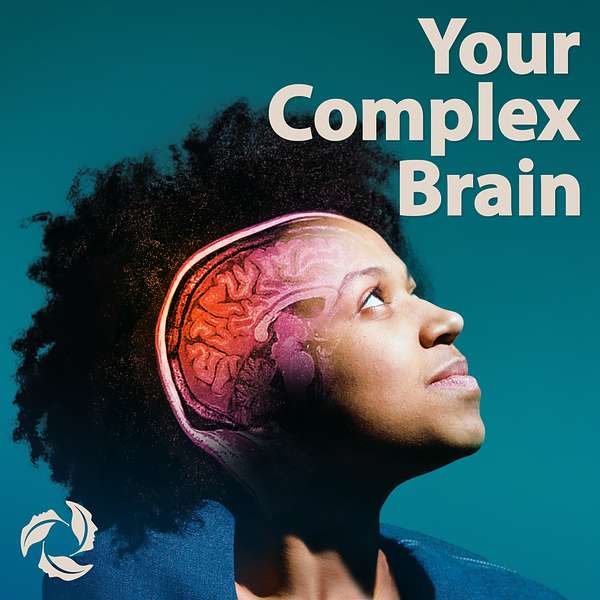
Your Complex Brain
Your Complex Brain
Dr. Kathryn Curtis' 5-Minute breathing practice
Breathing exercises are simple techniques can help improve your overall well-being by promoting relaxation, reducing stress, and increasing mindfulness. Listen to this original 5-minute 'Breathing Space' practice created by Dr. Kathryn Curtis for listeners of Your Complex Brain.
Dr. Kathryn Curtis is a clinical psychologist at the Comprehensive Integrated Pain Program at UHN, where she provides psychological services to individuals living with chronic pain. Dr. Curtis' research evaluates mind-body interventions, such as yoga and mindfulness, for populations experiencing chronic pain and mobility restrictions. She is a long-term student of eastern philosophy, meditation, and Vedic studies at Vidya Institute and integrating these eastern teachings into her clinical and research work is a passion of hers. In her spare time, Dr. Curtis enjoys spending time in nature with her family.
The Your Complex Brain production team is Heather Sherman, Jessica Schmidt, Dr. Amy Ma, Kim Perry, Alley Wilson, Sara Yuan, Meagan Anderi, Liz Chapman, and Lorna Gilfedder.
The Krembil Brain Institute, part of University Health Network, in Toronto, is home to one of the world's largest and most comprehensive teams of physicians and scientists uniquely working hand-in-hand to prevent and confront problems of the brain and spine, such as Parkinson's, Alzheimer's, epilepsy, stroke, spinal cord injury, chronic pain, brain cancer or concussion, in their lifetime. Through state-of-the-art patient care and advanced research, we are working relentlessly toward finding new treatments and cures.
Do you want to know more about the Krembil Brain Institute at UHN? Visit us at: uhn.ca/krembil
To get in touch, email us at krembil@uhn.ca or message us on social media:
Instagram - @krembilresearch
Twitter - @KBI_UHN
Facebook - https://www.facebook.com/KrembilBrainInstitute
Thanks for listening!
Hello, my name is Dr. Kathryn Curtis and I'm a clinical psychologist at Toronto Western Hospital, at the University Health Network in Toronto, Canada. It's really lovely to be here with you today, and I'd like to share a brief mindfulness practice called The Breathing Space.
This practice gives an opportunity to get centred, to integrate the mind, the breath and the body, and to do a powerful reset in the middle of your day. So let's get started. To begin, you can choose the position for your body. You can do this practice seated or lying down. So go ahead and make any adjustments you need to make to practice for about 5 minutes. Take a moment to feel the support beneath you as you rest. Now let your eyes gently close. Or if you prefer to practice with eyes open or have a history of trauma, then keep the eyes open, but steady, on a point for the duration of the practice.
Allow your attention to turn inward. Now notice the movements of your breath. Notice your breath flowing in and out on its own with no direction from you. Follow the breath flowing in through your nose or your mouth as it travels down through your throat and into your chest or belly. Follow the breath out from the belly or chest through your throat and out through your nose or your mouth. Simply following your breath with your mind, as it is, without needing to change it in any way. No need to make it deeper or more full, just allowing your body to breathe naturally and binding your mind to the breath as it moves in and out.
Breathing in and breathing out. Focus on the rise and fall of the breath. Moment by moment. Breath by breath.
Now, allowing your awareness to move beyond the breath to the sensations in your body. You might notice places of contact, temperature, tension or even discomfort. Just noticing the sensations you feel as they are, without judgment and with an open mind. And as you attend to the body, there might be thoughts arising. Just notice these thoughts for what they are without becoming wrapped up in the story behind them or lost in the content.
Notice them, label them as thoughts and with kindness. Return to the practice of observing. And if at any point you get lost in a rabbit hole of thoughts, simply return to noticing without judging yourself. This is the nature of practice. And now, expanding your awareness in such a way that you can be aware of your breath, your body and thoughts all at once.
Have a sense of your whole self-resting back, and breathing. As you breathe in, you might imagine that the breath could expand beyond the lungs, past the lungs into the body, so it can fill the whole body. And your body expands ever so slightly like a balloon. And then as you breathe out, the body releases. It’s breathing in, expanding and breathing out, releasing. Having a sense of your whole self-breathing, and then returning your mind to the simple flow of breaths for a few final, deep, nourishing breaths.
And in your own time and pace, bring your attention externally to the room around you. Gently move your hands and feet. And when you're ready, open your eyes. Thank you for joining me for practice today and take good care.
